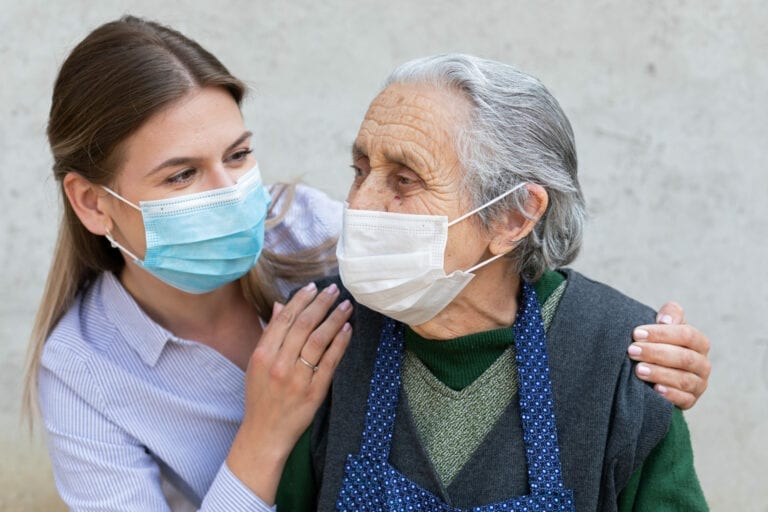In years past, it was common practice for members of the same family to offer in-home care for older family members. A great number of extended families went through the experience of growing old together and losing loved ones.
Before individuals turned to hospice care in the 1970s, most end-of-life care was provided in nursing homes and hospitals. Hospice care gained popularity during this time. Families may once more face the difficulties and enigmas associated with dying as the number of Americans using in-home hospice care increases.
What are the main end of life signs during final hours?
Although everyone’s path through end-of-life is different, here we discuss some of the most typical end of life signs final hours and discuss ways to make the process easier.
- Breathing difficulties
- Drop in body temperature and blood pressure
- Less desire for food or drink
- Changes in sleeping patterns
- Confusion or withdraw
1-Breathing difficulties
Breathing difficulties are one of the major end-of-life signs final hours. Patients may go for long stretches without breathing, followed by short, shallow gasps. In the final days of life, difficult or restricted breathing is typical. You may hear dyspnea or air hunger used to describe difficult breathing. Air hunger can be stressful for loved ones and frightening for hospice patients. That breathing concern can exacerbate air hunger and initiate a downward cycle of suffering in patients.
Solutions
Your physician may prescribe oxygen or raise your oxygen levels. Morphine is frequently used to treat respiratory difficulties. It dilates the pulmonary veins, allowing for deeper breaths. Patients may benefit from repositioning, vaporizers, relaxation techniques, or a breeze from a fan or window. The majority of hospice caregivers have expertise in mitigating breathing difficulties.
2-Drop in body temperature and blood pressure
As death draws near, the body’s temperature may drop by several degrees. Additionally, blood pressure will decrease, resulting in less blood flow to the hands, feet, nose, and lips. The patient’s skin may become bluish, pale, or mottled. Some individuals may alternate between being warm and cold.
Solutions
Utilize plush blankets to keep your loved ones warm. Do not use electric blankets since hospice patients frequently cannot communicate that they are too hot. A cool cloth on the forehead or a fan can relieve overheating people.
3- Less desire for food or drink
Patients in hospice may desire to eat but may encounter trouble swallowing or nausea. Diseases and medications can also alter the flavor of food. Food is commonly associated with nourishment and maintaining our vigor. For many individuals who are nearing death, food can aggravate stomach and digestive issues. Avoid forcing or pressuring loved ones to eat by enabling them to consume softened forms of food whenever they like. As the body progresses to active death, it frequently indicates a diminished appetite.
Nutrition is likely one of the most emotionally charged and guilt-inducing topics for patients and their families. There will come a point when the sufferer loses all appetite. No matter how distressing it may be for the family, the patient should not be coerced or pushed to eat.
Solutions
Provide little lunches to those who are still hungry. Serve meals at a time when patients are in less discomfort or are less agitated. Straw-equipped travel mugs allow patients to drink on their timetable. If someone refuses to consume food or liquid, flavored or unflavored ice chips help keep the mouth moist.
4- Changes in sleeping patterns
Your loved one may greatly lengthen their sleep duration. It is a natural consequence of having less energy and consuming less food. Some hospice patients may exhibit agitation, restlessness, or repeated gestures.
Solutions
Permit your loved one to rest. Your physician may prescribe pain or anxiety relievers.
5-Confusion or withdraw
Every individual approaching death has a unique state of mind. Near the end of life signs final hours, hallucinations, confusion, and diminished responsiveness are typical.
Solutions
Continue speaking with your loved one. Even if they do not react, it is possible that they can still hear you. The combination of gentle background music, muted lighting, and peaceful aromas can be pleasant. Identify yourself when speaking and maintain physical contact with your loved one.
Timeline for end-of-life changes:
Here are different timelines for end-of-life signs
2 weeks before death
Following are the signs 2 weeks before death
- More sleep
- Confusion
- Restlessness
- Visionary experiences
- Temperature, respiration, pulse, and blood pressure fluctuations are 2 weeks before death
- Congestion
- Not eating
48 hours before death
Following are the signs 48 hours before death
- Energy surges
- Lower blood pressure
- Glassy, teary eyes
- Half-opened eyelids
- Irregular breathing
- Increased restlessness
- Cold, purple, blotchy feet and hands are common 48 hours before death
- Weak pulse
- Lower urine output
3 minutes before death
Following are the sign 3 hours before death
- Gasping for air 3 minutes before death
- Not waking up 3 minutes before death
How will you know death has occurred?
Death can last for hours or days. No one can anticipate the time of a person’s death, even if they are experiencing typical end-of-life symptoms. This can occasionally result in exhaustion and bewilderment, and even if you are prepared for the dying process, you may not be ready for the moment of death. You and your loved ones may benefit from discussing what you would do in such a case.
Home Care Near Me. Let’s Get Started!
Get Immediate Help with Information, Costs & Payment Options.







